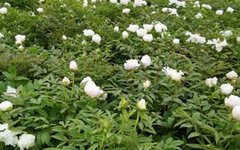This product is the dried root of the plant Paeonia lactiflora Pall. from the family Ranunculaceae. It is harvested in summer and autumn, cleaned, and the head, tail, and fine roots are removed. It is boiled in water, the outer skin is removed, or it is peeled and then boiled, and finally dried.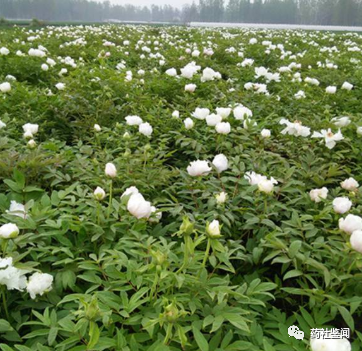
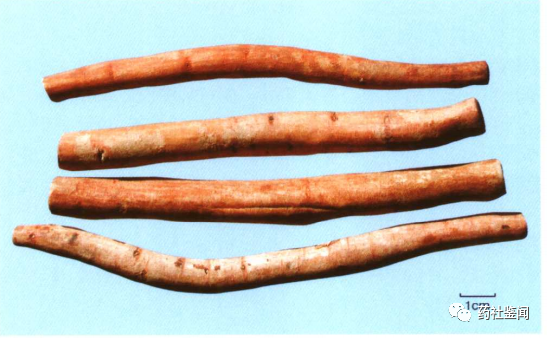
【Characteristics】This product is cylindrical, straight or slightly curved, with flat ends, measuring 5-18 cm in length and 1-2.5 cm in diameter. The surface is whitish or light brownish-red, smooth or with longitudinal wrinkles and fine root marks, occasionally with remnants of brownish outer skin. It is solid, not easily broken, with a relatively flat cross-section, whitish or slightly brownish-red, with distinct growth rings and radial rays. The aroma is faint, and the taste is slightly bitter and sour.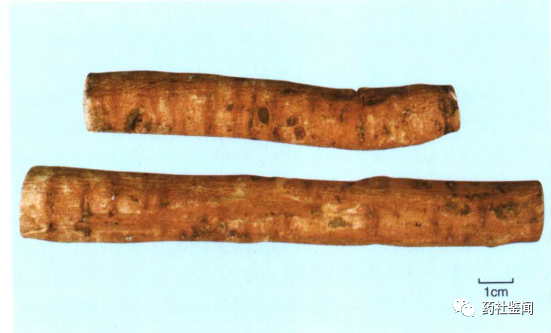
【Identification】(1) The powder of this product is yellowish-white. There are many gelatinized starch granules. Calcium oxalate clusters measure 11-35 μm in diameter, found in parenchyma cells, often arranged in rows, or several clusters in one cell. There are vessel elements with bordered pits and reticulated vessels measuring 20-65 μm in diameter. The fibers are long and spindle-shaped, measuring 15-40 μm in diameter, with thick walls, slightly lignified, and large round pits. (2) Take 0.5 g of the powdered product, add 10 ml of ethanol, shake for 5 minutes, filter, evaporate the filtrate, and dissolve the residue in 1 ml of ethanol to prepare the test solution. Take the reference sample of paeoniflorin, prepare a solution containing 1 mg per 1 ml of ethanol as the reference solution. Perform thin-layer chromatography (General Rule 0502), applying 10 μl of each solution on the same silica gel G plate, using chloroform-ethyl acetate-methanol-formic acid (40:5:10:0.2) as the developing agent, develop, dry, spray with 5% vanillin-sulfuric acid solution, and heat until the spots are clearly visible. In the test solution chromatogram, a blue-violet spot appears at the same position as in the reference solution chromatogram. 【Examination】Moisture content must not exceed 14.0% (General Rule 0832, Method 2). Total ash content must not exceed 4.0% (General Rule 2302). Heavy metals and harmful elements are determined according to lead, cadmium, arsenic, mercury, and copper testing methods (General Rule 2321, atomic absorption spectrophotometry or inductively coupled plasma mass spectrometry), with lead not exceeding 5 mg/kg; cadmium not exceeding 1 mg/kg; arsenic not exceeding 2 mg/kg; mercury not exceeding 0.2 mg/kg; copper not exceeding 20 mg/kg. Residual sulfur dioxide is determined according to the sulfur dioxide residue determination method (General Rule 2331), not exceeding 400 mg/kg. 【Extractable matter】Determined by the water-soluble extract method (General Rule 2201) using hot extraction, not less than 22.0%. 【Content determination】Determined by high-performance liquid chromatography (General Rule 0512). Chromatographic conditions and system suitability test use octadecyl silane-bonded silica gel as the stationary phase; acetonitrile-0.1% phosphoric acid solution (14:86) as the mobile phase; detection wavelength at 230 nm. Theoretical plate number based on the paeoniflorin peak should not be less than 2000. Preparation of the reference solution: Take an appropriate amount of paeoniflorin reference sample, accurately weigh, and dissolve in methanol to prepare a solution containing 60 μg per 1 ml. Preparation of the test solution: Take about 0.1 g of the product, accurately weigh, place in a 50 ml volumetric flask, add 35 ml of diluted ethanol, and sonicate (power 240 W, frequency 45 kHz) for 30 minutes, cool, add diluted ethanol to the mark, shake well, filter, and take the filtrate. The determination method involves accurately taking 10 μl of both the reference solution and the test solution and injecting them into the liquid chromatography system for measurement. This product, calculated on a dry basis, must contain not less than 1.6% of paeoniflorin (C23H28O11). 2. Chinese Herbal Pieces 【Processing】Bai Shao: Clean, moisten, slice thinly, and dry.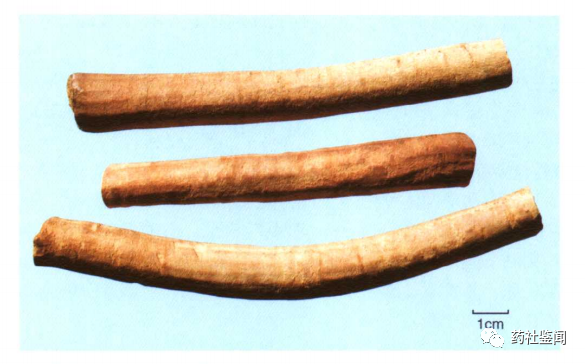
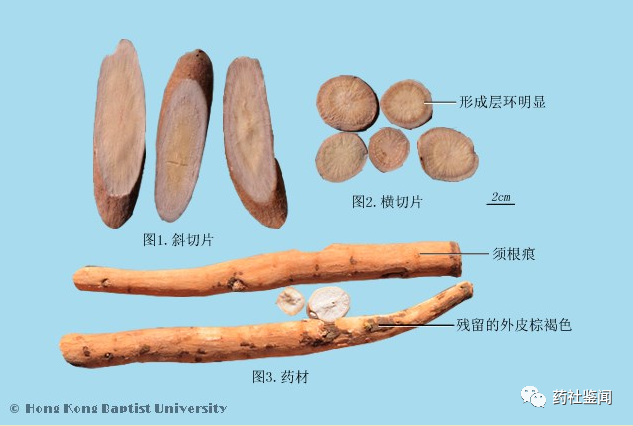
【Characteristics】This product is thin, roundish slices. The surface is light brown or whitish. The cross-section is slightly brownish or whitish, with distinct growth rings and slightly raised vein patterns arranged radially. The aroma is faint, and the taste is slightly bitter and sour.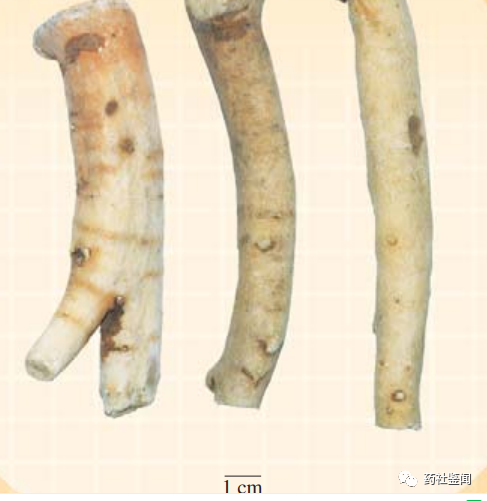
【Content determination】Same as the raw herb, containing not less than 1.2% of paeoniflorin (C23H28O11). 【Identification】【Examination】 (Moisture content, Total ash content, Residual sulfur dioxide) 【Extractable matter】 same as raw herb. Fried Bai Shao: Take clean Bai Shao slices, fry according to the dry frying method (General Rule 0213) until slightly yellow. 【Characteristics】This product resembles Bai Shao slices, with a slightly yellow or light brownish-yellow surface, some may show scorch marks. The aroma is faintly fragrant. 【Examination】Moisture content same as raw herb, must not exceed 10.0%. 【Content determination】Same as raw herb, containing not less than 1.2% of paeoniflorin (C23H28O11). 【Identification】【Examination】 (Total ash content, Residual sulfur dioxide) 【Extractable matter】 same as raw herb. Wine-fried Bai Shao: Take clean Bai Shao slices, fry according to the wine-frying method (General Rule 0213) until slightly yellow. 【Characteristics】This product resembles Bai Shao slices, with a slightly yellow or light brownish-yellow surface, some may show scorch marks. It has a faint wine aroma. 【Extractable matter】same as raw herb, not less than 20.5%. 【Content determination】Same as raw herb, containing not less than 1.2% of paeoniflorin (C23H28O11). 【Identification】【Examination】 (Moisture content, Total ash content, Residual sulfur dioxide) same as raw herb. 【Properties and Channels】Bitter, sour, slightly cold. Enters the Liver and Spleen channels. 【Functions and Indications】Nourishes blood, regulates menstruation, restrains yin and stops sweating, softens the liver and alleviates pain, pacifies liver yang. Used for blood deficiency with sallow complexion, irregular menstruation, spontaneous sweating, night sweats, flank pain, abdominal pain, limb cramping pain, headache, and dizziness. 【Dosage】6-15 g. 【Cautions】Should not be used with Li Lu (Veratrum). 【Storage】Store in a dry place, protect from pests. 3. Authenticity Identification 1. Genuine Bai Shao: The herb is the dried root of the plant Paeonia lactiflora Pall. from the family Ranunculaceae. This product is cylindrical, mostly straight, with flat ends. It measures 5-18 cm in length and 1-2.5 cm in diameter. The surface is whitish to reddish-brown, with longitudinal wrinkles and fine root marks, occasionally with remnants of brownish outer skin. It is solid, not easily broken, with a relatively flat cross-section, whitish or slightly brownish-red, with radial wood structure. The aroma is faint, and the taste is slightly bitter and sour. Bai Shao is classified by origin: Hang Bai Shao, Chuan Bai Shao, Bo Bai Shao. 2. Non-genuine Yun Bai Shao: The herb is the dried root of the plants Paeonia delavayi Franch. (Yellow Peony) and its varieties. This product is cylindrical, measuring 10-18 cm in length and 1-2.5 cm in diameter. Both ends are flat, with a grayish-yellow to brownish-yellow exterior, with distinct longitudinal wrinkles and root marks. It is solid, not easily broken, with a less flat cross-section, light yellow, slightly corky, with radial wood structure. The aroma is faintly fragrant, and the taste is slightly bitter and sour. 3. Non-genuine Mao Guo Bai Shao: The herb is the dried root of the plant Paeonia lactiflora Pall. var. trichocarpa (Bunge) Stern. This product is mostly long and tapered, thicker at the top and thinner at the bottom, with uneven ends, measuring about 10-20 cm in length and 1.5-2 cm in diameter. The outer skin is brown, varying in shade, with unremoved cork showing brownish spots. It is hard, heavy, not easily broken, with a powdery cross-section. The aroma is faint, and the taste is slightly bitter and sweet.
Long press to identify the QR code to learn about new trends in medicine!

